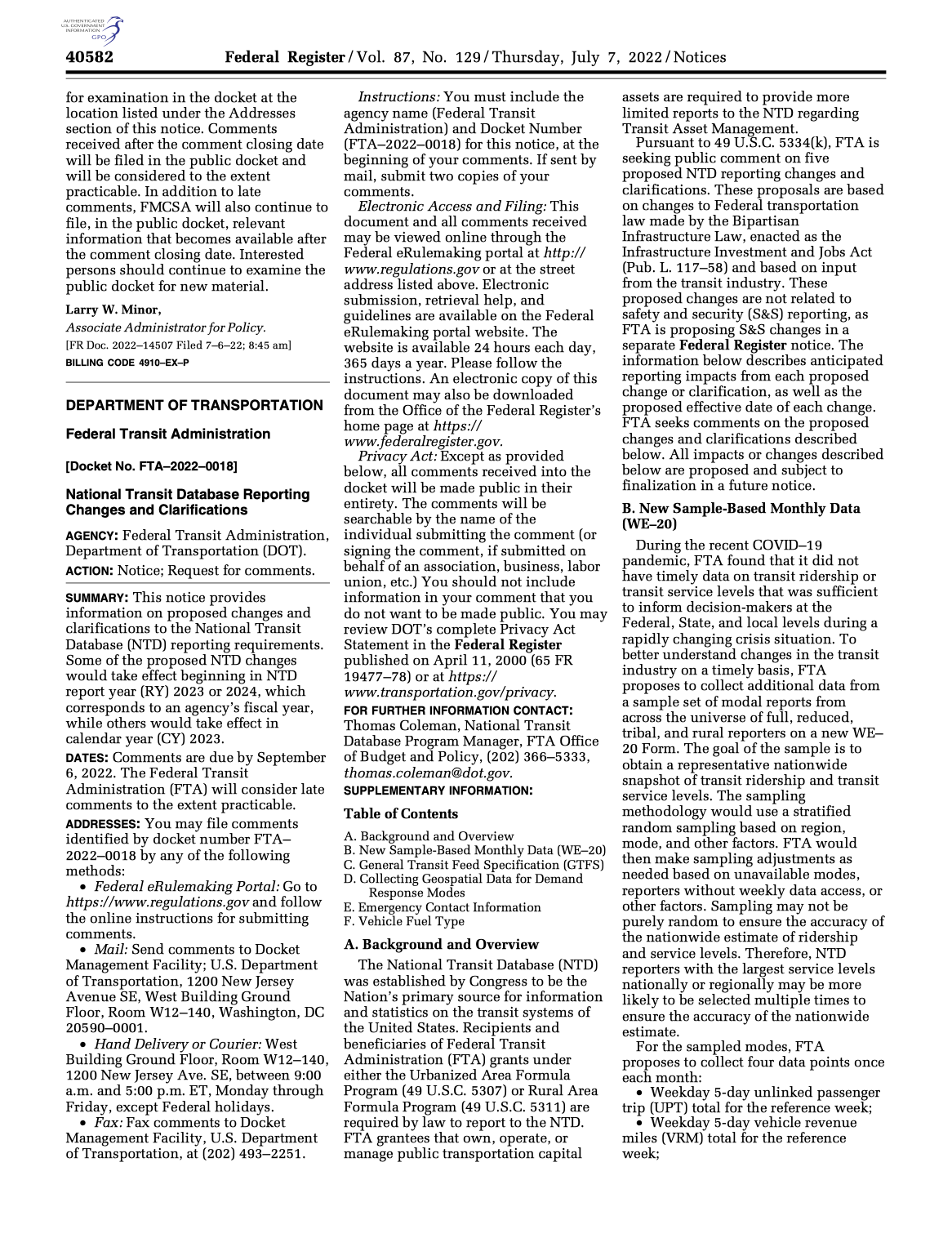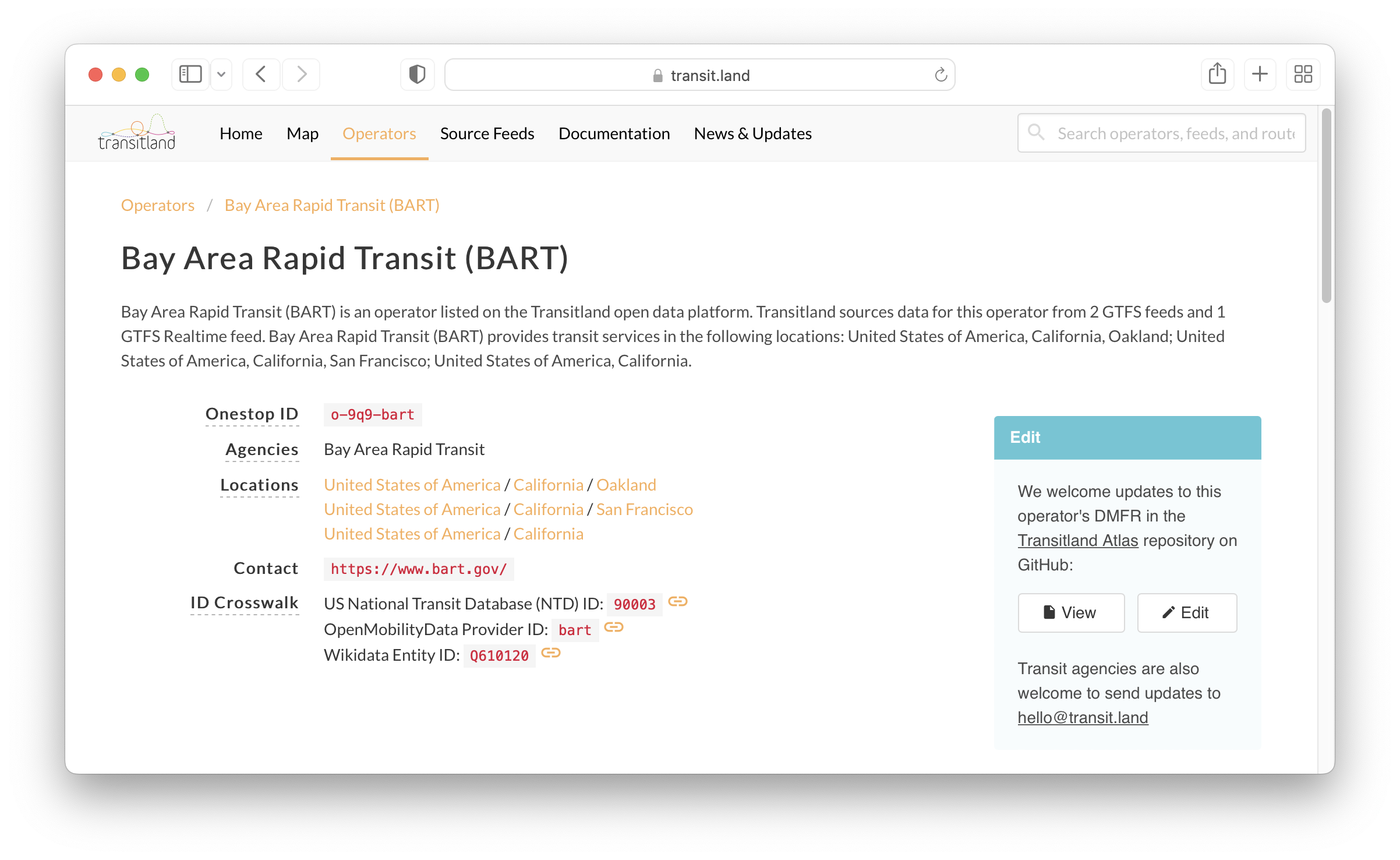US National Transit Database to collect GTFS URLs
April 28, 2023: The Federal Transit Administration has now adopted these new reporting requirements. For a brief overview, see our more recent blog post describing when FTA will begin requiring US transit agencies to submit URLs for their GTFS feeds to the National Transit Database.
American public transit agencies that receive federal funds are required to report information for inclusion in the National Transit Database. The Federal Transit Administration, which administers to NTD, is proposing that each agency will also provide a URL for a GTFS feed in their NTD reports. Submitted GTFS feeds will enter the public domain. This is great news for all producers and consumers of GTFS data.

We’ve submitted feedback to the FTA based on our experience building and operating Transitland, and we’re sharing it here as well:
At Interline Technologies, we specialize in software services for GTFS, GTFS Realtime, and related data specifications. Our Transitland data platform (www.transit.land) aggregates open-data feeds from over 3,000 operators in over 50 countries, including 908 operators in the United States. We serve organizations that both produce and consume these data feeds. Our clients include public transit agencies, private mobility providers, planning firms, and academic research institutions. This is just a sampling of the many types of firms that make use of GTFS and related data feeds.
Based on our own experience, as well as the experience of our clients, we see much value in FTA’s proposed addition to the NTD reporting process to have agencies provide a public GTFS feed. Increasing the number and accessibility of openly licensed GTFS feeds with stable URLs from American transit agencies will have many benefits. In addition to being useful for transit trip planning (the best known use-case for GTFS), this will also assist with transportation planning, land-use planning, real-estate assessment, academic research, and local advocacy. Coverage of the largest and the smallest transit agencies is important for many of these endeavors, as is comprehensive coverage of both urban and rural operators. Using NTD reporting to promote the production and open sharing of GTFS data feeds will assist with all of these use-cases.
We are pleased to see that agencies will be encouraged to report a stable URL that is updated on their own servers. Transitland and similar data aggregators operate best when the “source of truth” for each feed is maintained on each agency’s servers and the aggregator fetches from that location on a regular basis.
We encourage FTA to consider multiple means of distributing the lists of GTFS feed URLs. While most NTD data is included in a single Excel file with multiple sheets, we would propose that FTA also disseminate a separate file that just lists GTFS feed URLs. Ideally this would be in the CSV format, be hosted at a stable URL, and include the associated NTD IDs for each GTFS feed URL. In addition to the NTD ID, we suggest also listing the agency’s ID used on the NTD website for agency profile pages. For example, the final portion of
https://www.transit.dot.gov/ntd/transit-agency-profiles/san-francisco-bay-area-rapid-transit-district
FTA may consider posting a CSV listing the feed URLs, associated NTD IDs, and NTD website IDs to an open-data portal such as data.gov on an ongoing basis. This will be useful for a very wide range of users.
At present, our staff and external contributors maintain associations between GTFS feed URLs and NTD IDs in the Transitland Atlas repository on GitHub. It is open to public use and contributions at https://github.com/transitland/transitland-atlas While we believe this structure is likely more complex than is necessary for FTA and NTD’s purposes, we offer this as one example for how to provide information on many feeds, along with metadata about each operator and (when relevant) its US NTD ID.

Finally, we strongly support the proposed change that “upon publication, all GTFS data submitted to the NTD will enter the public domain.” Since 2014, our team has been working to improve the state of licensing for GTFS data. At our last company (Mapzen) we prepared a model license for GTFS feeds and discussed it in depth with USDOT OST staff. At Interline, we continue to assess the state of licenses and terms attached to public transit data. In the Transitland Atlas repository mentioned previously, our staff maintain metadata about the licenses attached to many of the feeds. This is important for our institutional clients, so they can be assured that we and they are making a good faith effort to follow the license and terms for each agency. However, all of this effort to track and review such a wide range of licenses is resource intensive. We do not think it is a good use of anyone’s time. Furthermore, we do not believe it benefits or protects transit agencies that produce GTFS data. GTFS feeds contain no privileged data, nor do they contain personally identifiable information (PII). Publishing a GTFS feed in the public domain does not entail giving up other protections such as a transit agency’s trademark of their brand name and logo. Transit agencies benefit when their GTFS feeds are useful widely by as many consumers as possible. We are pleased to see FTA proposing to simplify this overly complicated situation by instead requiring that GTFS feeds submitted to the NTD reporting process enter the public domain.
Thank you for taking these comments. You are welcome to reach us at info@interline.io if we can provide any more information.
Originally posted to the Interline blog on September 7, 2022.
Written by: